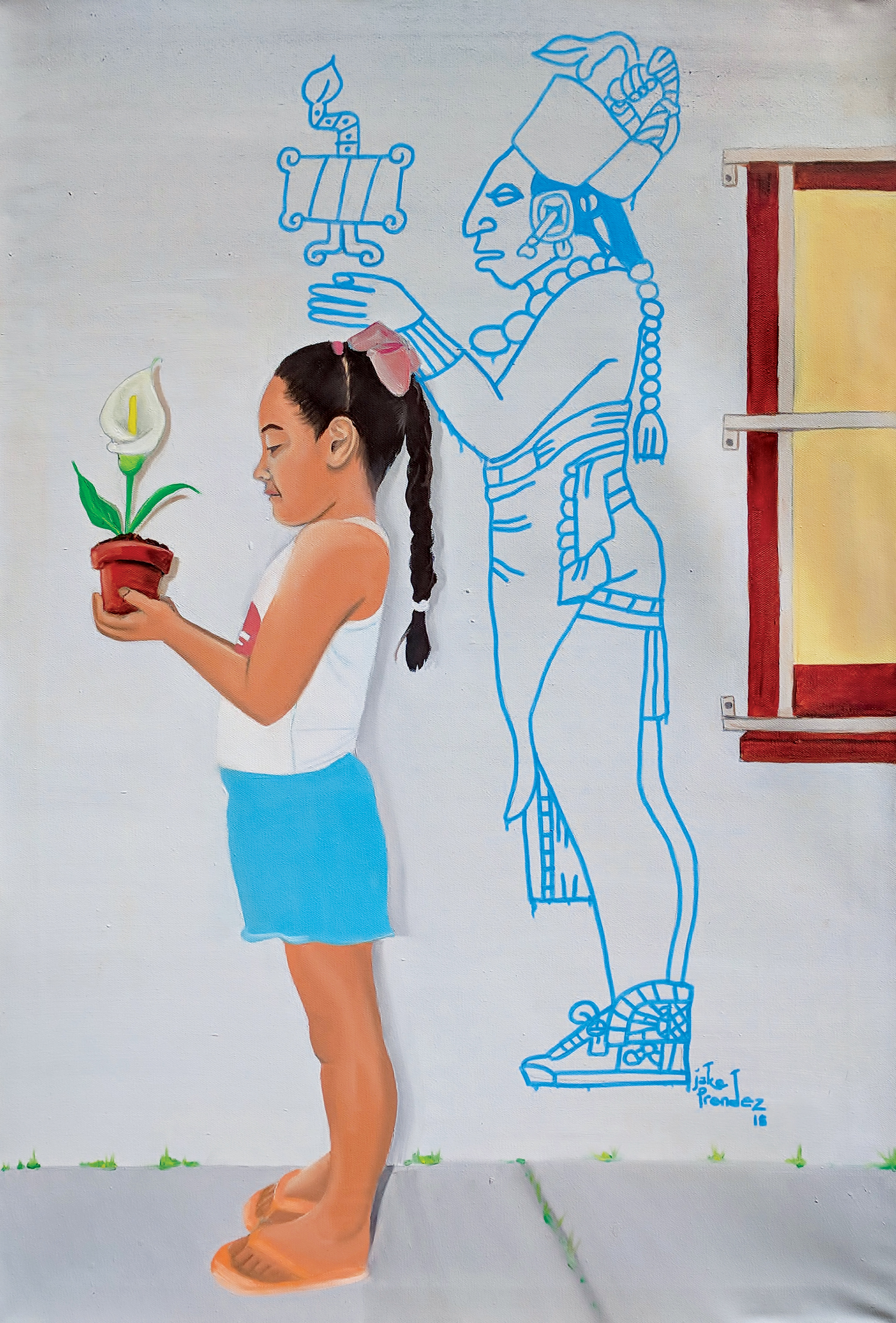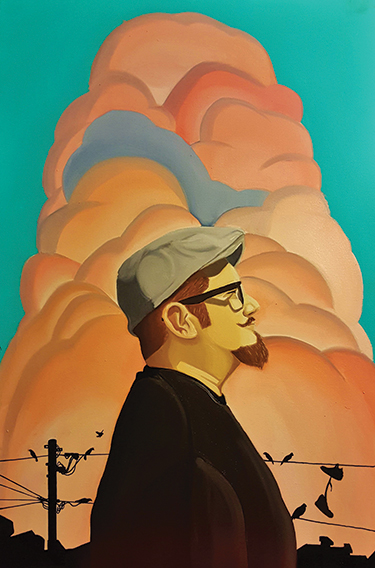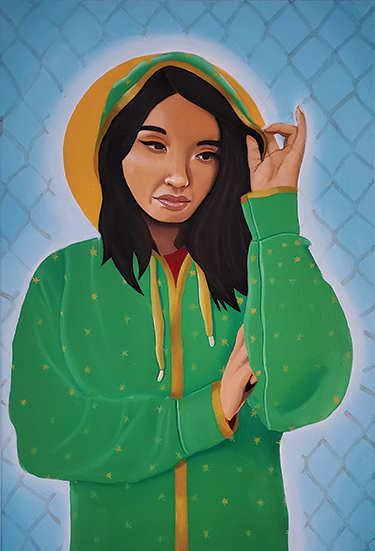Painting the way
for Latinx artists
Painting the way
for Latinx artists
Painting the way
for Latinx artists
Jake Prendez, ’00, knows what it's like to feel like an outsider. Now he offers fellow Latinx artists a place to showcase their work.
By Julie Davidow | Art by Jake Prendez | May 2020 | Viewpoint Magazine

Though Sophia Vazquez does not see many students who look like her when she walks around UW, she hears the familiar sounds of home. Her earbuds, filled with the Spanish-language music her mom played in the car and while cleaning the house on weekends, evoke her Mexican roots even as she feels like an outsider.
“The music is what really holds me together right now,” says 19-year-old Vazquez, who started at the UW in the fall. A range of songs, from Selena to Shakira and cumbia, populates her playlist.
Vazquez always knew she was college bound, but she was never sure where—or if—her Mexican identity fit in that plan. Although her high school in Federal Way was more than 50 percent Latinx, the honors classes where she spent most of her time lacked diversity. She worried about standing out if she called attention to her heritage. “I didn’t like being different,” she says.

“It Is What It Is,” a self-portrait of Jake Prendez from 2018.
Then, on a whim, she joined the first session of an arts residency program for Latinx teenagers led by Chicano artist Jake Prendez. “Suddenly I was in a group of kids who were all like me,” says Vazquez, whose parents met in California. Both sides of her family came from the Mexican state of Jalisco.
The Próxima Generación: Youth Residency Project introduced Vazquez to artists and activists who encouraged the teens to consider their own role in sustaining cultural traditions. “I became more comfortable being able to connect with my roots,” Vazquez says.
Prendez, ’00, knows what it’s like to be on the outside. As a Mexican teenager in Bothell in the 1990s, he faced constant reminders that he didn’t belong. Once, police stopped his group of black and brown friends and held guns to their heads because they said the 14-year-olds matched the description of a robbery suspect. A math teacher at his high school handed out word problems based on racist stereotypes of African Americans and Latinos. Art teachers told him his work was too ethnic.
“I quit art after my first year in college,” says Prendez, who attended Bellevue Community College before transferring to UW. “I thought, finally an art teacher will get me. They will see me. But they just perpetuated the same thing I heard from everyone else.”
After struggling with school as a child and teen, he found a major—American Ethnic Studies—that helped him make sense of the racism he experienced. He graduated from UW with honors and moved to Los Angeles for a master’s program at California State University at Northridge. Making art became a “side hustle” while he worked for more than a decade as a college recruiter at Northridge and as an events coordinator for the Los Angeles Unified School District. Four years ago, when his son enrolled at the UW, Prendez moved back to Seattle and made art his full-time pursuit.
“I’m tired of folks talking about Mayans and Aztecs as an extinct people. We’re still here. Our culture survives in the way we cook, the way we dance, the way we work with our elders.”
Jake Prendez
His paintings meld the past and present of Latinx experience, identity and culture. A series called “Contemporary Codices” layers Aztec imagery on modern subjects—a baseball player from the Los Angeles Dodgers, a girl taking a selfie, a woman on her laptop. “I’m tired of folks talking about Mayans and Aztecs as an extinct people,” Prendez says. “We’re still here. Our culture survives in the way we cook, the way we dance, the way we work with our elders.”
Often his work explicitly tackles political subjects. “Our Lady of the Detention Centers,” for example, features a woman in a hoodie, her eyes averted. “I wanted to have a teen angst version of Our Lady of Guadalupe—a young woman who would blend in but she’s looking over the folks in the detention centers.”

“Our Lady of the Detention Centers,” 2019, blends teen angst and Latinx culture.
Prendez opened the Nepantla Cultural Arts Gallery in White Center last year to showcase Latinx artists and to host the kids from Próxima Generación. “Nepantla” is an Aztec term used by anthropologists and others to describe being in the middle, often between two cultures or communities. It can reference being in between two cultures or communities.
Prendez, who runs Nepantla with his partner Judy Avitia-Gonzalez, wanted Latinx students like Vazquez to have a place to celebrate and learn about their culture. Nepantla is also open to members of any community who feel threatened or endangered, Prendez says. “We want to take care of those who feel like they don’t have a place. This is their place.” The gallery stages monthly exhibitions with artists from marginalized communities and is also home to a gift shop stocked with clothing, jewelry and crafts made by artists around the country.
For Vazquez, everything clicked at Próxima when a medical professional came to speak to her group. The doctor’s commitment to folklórico (traditional Mexican dance) made her realize she did not need to segment her heritage from the rest of her life. She became president of her high school’s Latino Student Union. At the UW, she chose a major in Education, Communities and Organizations to learn skills to serve the Latinx community.
“That group really changed my life,” Vazquez says. But the most significant changes may be the everyday moments no one else sees. Now when she seeks comfort listening to Spanish music on her way to class, she credits Próxima.
Below, listen to a Spotify playlist curated by Vazquez.
At top: “Genetic Memory,” a 2018 oil on canvas, captures Prendez’s approach for youth empowerment, his penchant for positive imagery and his connection to his Indigenous roots.